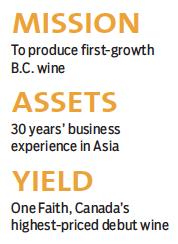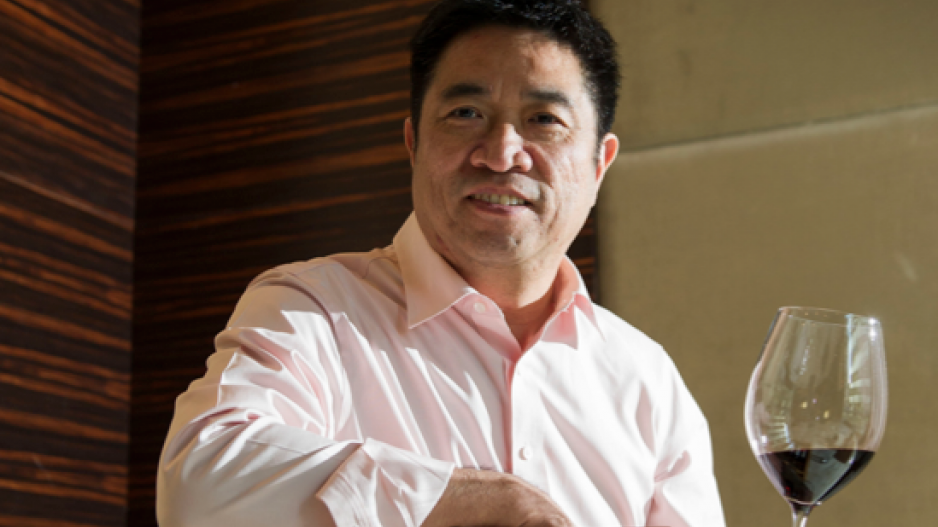Reinvestment is the catchword of the B.C. wine industry. Twenty-five years ago, after the pullout of vines that accompanied the Canada-U.S. Free Trade Agreement, the sector rebuilt itself from scratch, and a decade later an influx of cash from executives in the financial, oil and tech industries fuelled a second wave of growth.
Now, a new tide of investment is rising in the Okanagan. Capital from China is flowing in, brought by new immigrants and formerly expat Canadians who have returned to this country familiar with the opportunities Asia presents.
Among the new investors is Bill Lui, who spent two decades in his native Hong Kong manufacturing health-care products for sale at some of the world’s biggest and best-known retailers, including Walmart, Walgreens, Canadian Tire and Shoppers Drug Mart. Selling the manufacturing business in 2005 and returning to Vancouver, he dreamed of producing wines similar to those he had come to know and love during business dinners in Asia.
If icewine was Canada’s flagship beverage overseas, Lui knew the industry was capable of more.
“The Okanagan is a new wine region that has a lot of potential, to be introduced around the world,” he said over a glass of the debut wine from his latest venture, One Faith Vineyards. “I want to tell people in Asia that Canada can make good wine. … This is my faith, that I can help promote Canadian wine. I believe this wine has the structure, has the quality, has every characteristic that people in Asia will say, ‘Wow, this is good.’”
But if Lui’s goals are lofty, so is the image his wine projects.
The initial release, in a hefty bottle bearing an elegant label, sold for $495 per three-bottle case – or about $165 a bottle, the highest price ever asked for a newly released British Columbia wine, let alone a debut release from an untested winery. Harry McWatters garnered headlines for releasing Sumac Ridge Estate Winery’s red blend Pinnacle at a mere $50 in 2003, and more recently LaStella Winery in Osoyoos has been commanding $100 for its Maestoso.

Lui, however, positions his wine as “first growth,” a term that traces its origins to the official Bordeaux classification of 1855, an exclusive list of top-ranked wines that includes just five châteaux: Château Latour, Château Lafite Rothschild, Château Margaux, Château Haut-Brion and, most recently, Mouton Rothschild.
“I want my wine to be first growth,” Lui said. “I need a slogan for myself. When I go market my wine in Asia, I would tell them this is Canadian first growth.”
It’s an ambitious claim, especially in the New World; producers in California’s Napa Valley, including Harlan Estate and Screaming Eagle, have achieved the distinction – but a winery claiming the honour for itself is another question. Still, Lui asks, “They have first growth in Napa; why can’t we have first growth in Canada?”
The wine has won a high-profile endorsement, however.
Tasting the wine in Florence, Italy, last spring courtesy of Vancouver wine educator James Cluer (a consultant to the project), U.K. wine writer Jancis Robinson was so taken by its presentation and character that she declared, “Easy to see how it has become a cult wine in B.C.”
“A veryfancy full-colour brochure gave me the impression that it was already firmly established,” she told Business in Vancouver.
The affirmation encourages Lui, who believes Asia needs to see – and taste – Canada’s wine at its best.
“Our premier is telling us to export. If you don’t have the right product, how do you export?” he asked.
The role of vintner is new for Lui, who speaks about his wines from Cluer’s tasting notes.
Lui came to Canada in 1968 at the age of 10 and received his bachelor’s degree from Wilfrid Laurier University in Waterloo in 1979, majoring in chemistry. He worked for Philips Electronics Ltd., then moved to Taiwan as marketing manager for a computer component manufacturer. He stayed 10 years, married, then moved to Hong Kong and started his own company manufacturing private-label medical devices – everything from thermometers and blood pressure monitors to massage pads.
Setting up a factory in Guangdong the year of the protests in Tiananmen Square was an eerie experience.
“It was so quiet, nobody was there. I was a little scared,” he said. “But when things are quiet, it’s easier for me to develop business. Because nobody went in, I could go in.”
An entrepreneur at heart, Lui says he’s willing to spare no expense in the development of his One Faith brand and the production of premium wines to rival those of the Old World.
Harry McWatters’ vineyard on Black Sage Road, tended by veteran viticulturist Richard Cleave, supplied the grapes. Napa winemaker Anne Vawter flew in to oversee production (One Faith doesn’t have its own premises so it secured space at an existing facility). Lui’s own training was acquired at the first-growth châteaux of France and courses at the University of California, Davis.
He’s got the technical aspects covered, and the cash to get things right.
But why the Okanagan; why not California or even France?
Lui acknowledges it would likely be simpler.
“I have the luxury to go anywhere. I could make wine in Bordeaux. … I have the financial backup to do it,” he said. “[But] I don’t want it to be like it was before, where 25 days of my time was in China, or 10 days in Europe and a few days in the States looking for business. I want to stay close to my family [in Vancouver].”
Winemaking, he says, has given him a freedom he never had – freedom to golf, volunteer at his daughter’s school and spend time with his family.
Meanwhile, he hopes his connections in Asia will advance the reputation of the Okanagan wine industry, alongside the likes of Osoyoos Larose, Painted Rock Estate Winery and others.
“I can use my experience, my connections, to make things happen,” he said. “But we need a lot of people like Painted Rock, myself … in order to promote Canadian wine. You cannot just have one guy go.” •




